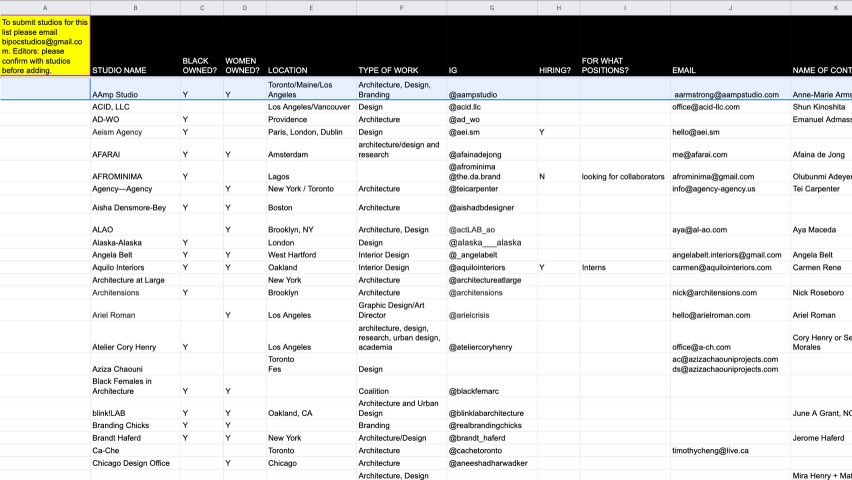
Architects and designers create Google Docs spreadsheet listing black-owned studios
Architects and designers have created a public Google Docs spreadsheet to highlight design, architecture, engineering or planning studios founded by black, indigenous and people of colour.
Fashion designer Virgil Abloh, architects Dong-Ping Wong, Tei Carpenter, Dominic Leong, Preeti Sriritana, Oana Stănescu, Joey Swerdlin, Naïla Opiangah, critic Esther Choi, artist Hassan Rahim, and designer Mahfuz Sultan made the spreadsheet to document minority studios that may have job opportunities.
Called BIPOC Studios, the acronym for black, indigenous and people of colour, the spreadsheet was made public on 4 June following the death of George Floyd in police custody. It currently lists 108 studios and the group intend to update it continually.
BIPOC studios listed with job openings
"A live and growing list of BIPOC architecture, industrial design, landscape, graphic design, urban planning, fabrication... studios from around the world," said architect Dong-Ping Wong in a photo posted to Instagram.
"About half of them black-owned and led."
Among the main aims of the project is to raise awareness of jobs available at studios and encourage emerging architects and designers to apply for them.
"If you own, run, work at or know of BIPOC-owned design, architecture, engineering or planning studios please DM me with info," said architect Dong-Ping Wong in a photo posted to Instagram. "I'm compiling a public google doc to make it easier to find jobs at these studios."
Columns highlight black- or women- owned studios
Contributors fill out a series of columns in the spreadsheet that include name, location, type of work, whether the business is black- or women- owned, and whether they have job opportunities. Dong-Ping, who runs New York firm Food, has encouraged users to send their portfolios to the studios either way.
"For the young designers looking to apply to offices and seeing a ton on the list that aren't labelled as hiring, send them your portfolios anyway," Dong-Ping said. "It doesn't mean they aren't hiring and trust me you never know where an office is at week by week, including mine."
Architecture institutions respond to racial inequality
George Floyd died on 25 May when a white police officer knelt on his neck for nearly nine minutes, setting off protests against police brutality and racism across the US.
Architects, designers and institutions responded to the unrest after Floyd's death by accepting the profession's responsibility for racism and calling for it to be proactive in creating racial equality.
Leaders of the Minnesota chapter of the American Institute of Architects admitted they had done "too little in the past" to address the systemic inequities, while the National Organization of Minority Architects amended its mission statement in a bid to "take an active role in eliminating racial biases".